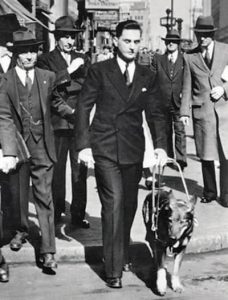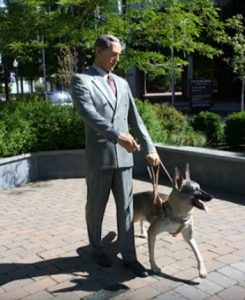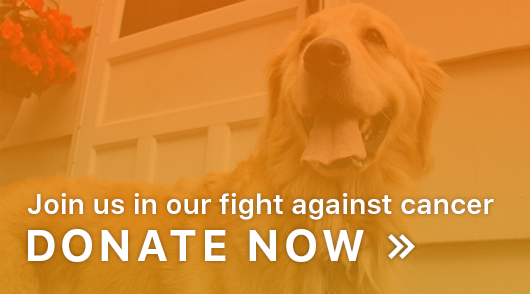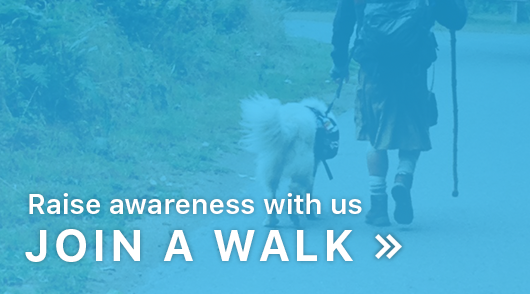
Morris Frank and his German Shepherd, Buddy.
From Pet Peeps
January 29th is National Seeing Eye Dog Day. Seeing eye dogs are service dogs specially trained to be the eyes for their visually impaired owners. Typically Labrador Retrievers, Golden Retrievers and German Shepherds are chosen as seeing eye dogs, since these breeds are capable of complex training, and staying calm and focused when necessary.
If you’ve ever watched a seeing eye dog being trained or guiding a blind person, you’ve probably been amazed at the intricacy of what they do and the amount of trust their owners place in them. That’s because seeing eye dogs are incredibly trustworthy. When in harness their singular purpose is to keep their owners safe and steer them on the right path. (Sometimes, when out of harness, a whole other, playful personality emerges, which makes their training all the more impressive!)
Seeing eye dogs are often specially bred by organizations that train and place them. They may spend a portion of their early life with a foster family, but they are placed in intensive training at a malleable age and train hard before they ever meet their future owner. Once matched with an owner, the dogs and owners train together for a lengthy period of time before they’re sent home to start their partnership in earnest.
Most seeing eye dogs work with their owners for 8-10 years, if healthy and if no behavioral problems arise. Once retired, many go to loving adoptive families.
Many schools for seeing eye dogs are nonprofits and rely heavily on donations to survive. Consider making a donation in honor of the good work these faithful dogs do! For more information, visit The Seeing Eye online or find a school near you.

Statue of Morris and Buddy 2.
From The Bark
In New York City on June 11, 1928, Morris Frank took one big step for the disabled and one giant leap for assistance dogs. The 20-year-old Tennessean, who lost his sight at 16, was fresh off the SS Tuscania after a month in Switzerland, where he had been trained by Dorothy Eustis to work with his first guide dog, a female German Shepherd named Buddy. A group of curious, incredulous reporters greeted him at the dock, demanding to know what exactly this dog could do for him.
The previous month had bolstered Frank’s native Southern swagger, and he boasted that Buddy could take him anywhere. “Even across West Street?” they asked. Known locally as “Death Avenue,” it was one of the city’s most hazardous thoroughfares. Frank reportedly declared, “Show me to it, brother, and Buddy will take me across it.”
Making good on his claim, the pair began to negotiate the wide cobblestone street against a backdrop of clopping hooves, blaring horns, screeching brakes and the clamor of commerce. Buddy led her tall, blind master in his well-cut suit safely across to the opposite curb.
This was the first time Americans had seen a guide dog in action, but certainly not the last. Frank and Eustis went on to create The Seeing Eye six months later, and before long, people assisted by dogs became part of daily life.
Before I became a guide dog mobility instructor, I had no real idea what guide dogs did, much less how they did it. After eleven years of training service dogs for the blind, however, I can give you some highlights of the amazing feats these dogs do every day for their people.
Most of us know that dogs have a sensational sense of smell; the difference between their olfactory ability and ours is so huge that we can’t really comprehend it. But to me, one of the most astonishing things about guide dogs is that they are asked to constrain this quintessential faculty. They can’t wander nose to the ground, following an invisible trail this way and that. Doing their jobs requires them to override a very powerful and innate inclination.
Dogs are also adept at social intelligence; they “read” us really well. Guide dogs put this skill to use every moment they’re on duty, responding appropriately to the variety of gestures and verbal commands a blind person uses when working with a dog, including directional cues like “forward,” “left” and “right.”
We expect them to obey these commands and generally, they do. But sometimes, they’re required to make an independent assessment of a situation, and to intelligently disobey if complying would put their person in danger. For example, if there’s an open manhole cover in our path, we want them to ignore the “forward” command. Same goes for subway platforms, tight spaces and, most importantly, traffic passing in front of us as we’re about to cross the street.
Guide dogs put their memories to work as well, recalling not just the place they last saw a squirrel or a cat under a bush (both of which they’re trained to ignore), but also, their person’s bank, grocery store and favorite coffee shop. And, of course, they remember the home they share with their person. That’s particularly helpful if the individual loses his or her sense of direction.
So, back to 1928. Imagine you’re Buddy. As you begin to cross, you encounter a kaleidoscope of activity; the pungent smells of rotting produce, horse manure, and oil and gas from ships and automobiles; and the constant din of horses and cars and trolleys. To the astonishment of those watching, you safely take Morris Frank through this hurly burly to the other side of the street. It’s nothing short of a miracle.
Modern-day guide dogs accomplish this miracle, and many more, every day. But what seems phenomenal to us is run-of-the-mill for them. Fortunately, the capacities and senses with which they’ve been endowed can, with appropriate training, be harnessed to guide humans. It’s one of the most mutually beneficial partnerships ever conceived.
You can play a part in these “everyday miracles” by donating money or time to the organization of your choice. Whether you’re writing a check or raising a puppy, you’re helping to enhance the independence and dignity of the blind and visually impaired through these remarkable partnerships.
For a video of Morris and Buddy, follow this link.
Sources:








